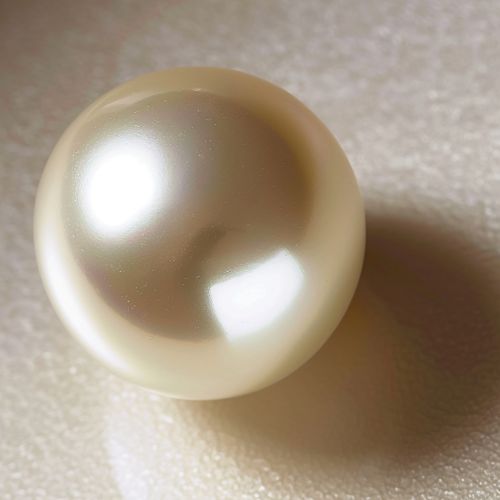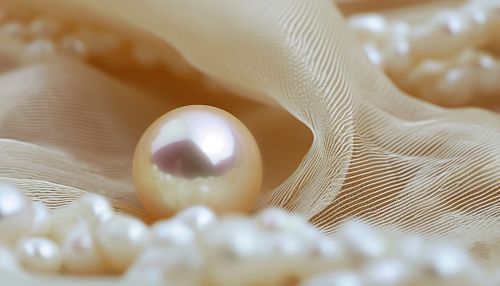Pearl (gemstone)
Formation and Structure
Pearls are formed within the soft tissue (specifically the mantle) of a living shelled mollusk. Just like the shell of a mollusk, a pearl is composed of calcium carbonate in minute crystalline form, which has been deposited in concentric layers. The ideal pearl is perfectly round and smooth, but many other shapes, known as baroque pearls, can occur.
Pearls are formed when an irritant, such as a bit of food, a grain of sand, bacteria, or even a piece of the mollusk's mantle becomes trapped in the mollusk. To protect itself from irritation, the mollusk begins to cover the irritant with layers of nacre. This is the same substance that the mollusk uses to create its shell. This process is not unlike the manner in which the human body reacts to a foreign substance, and begins to coat it with layers of calcium.
The process of pearl formation can take up to seven or eight years. The size of the pearl can vary, depending on the size of the mollusk, the amount of time the pearl was left to grow, and the conditions of the water.


Types of Pearls
There are several types of pearls, each with their own unique properties and characteristics. These include:
- Natural Pearls: These are formed without any human intervention and are very rare and valuable. They are often found in the Persian Gulf, and are typically white or cream-colored, with a slight tint of the color of the water in which they were formed.
- Cultured Pearls: These are formed when a tiny bead or piece of shell (the nucleus) is inserted into the mollusk by a pearl farmer. The mollusk then covers the nucleus with nacre, just as it would a natural irritant. Cultured pearls are the most common type of pearl found in jewelry today.
- Freshwater Pearls: These are formed in freshwater mussels. They are often irregular in shape and have a different luster from saltwater pearls. They can be found in a variety of colors, including pink, peach, lavender, plum, purple, and tangerine.
- Saltwater Pearls: These are formed in saltwater oysters. They are typically more round and have a higher luster than freshwater pearls. They include the Akoya, South Sea, and Tahitian pearls.
- Baroque Pearls: These are pearls that have irregular shapes. They can be either freshwater or saltwater pearls. Their unique shapes make them a popular choice for many types of jewelry.
Pearl Grading
Pearls are graded on the following factors: size, shape, color, luster, surface quality, and nacre quality. The Gemological Institute of America (GIA) classifies pearls into three main categories: natural, cultured, and imitation. The GIA also uses a grading system for cultured pearls based on luster, nacre thickness, shape, color, surface, and matching.
- Size: Pearl sizes are measured in millimeters. The size does not affect the quality of the pearl, but it can affect its price. Larger pearls are rarer and more valuable.
- Shape: Pearls come in eight basic shapes: round, semi-round, button, drop, pear, oval, baroque, and circled. Round pearls are the most valuable.
- Color: Pearls come in a variety of colors, including white, black, gray, red, blue, and green. The color of a pearl can affect its value. The most valuable pearls are often white or black with rose or silver overtones.
- Luster: This refers to the reflective quality or brilliance of the pearl. The more lustrous the pearl, the more it shines and reflects light. High luster is a sign of a high-quality pearl.
- Surface Quality: This refers to the presence of surface defects or blemishes. The fewer the blemishes, the higher the quality of the pearl.
- Nacre Quality: This refers to the thickness of the nacre. The thicker the nacre, the longer the pearl will last and the more luster it will have.
Pearls in History and Culture
Throughout history, pearls have been revered as a sign of wealth and status. In ancient Rome, pearls were considered the ultimate status symbol. The Greeks believed that pearls were the tears of the gods. The Chinese have prized pearls for centuries for their medicinal properties and their symbolic representation of purity and innocence.
In many cultures, pearls are traditionally given as wedding gifts because they symbolize purity and innocence. In the Hindu religion, pearls are also seen as a symbol of love and are used in wedding ceremonies.
Pearl Care and Maintenance
Pearls require proper care to retain their beauty and value. They should be kept away from chemicals, including makeup, perfume, and hairspray, as these can damage the surface of the pearl. Pearls should also be kept separate from other jewelry to avoid scratching. After wearing, pearls should be wiped down with a soft cloth to remove any traces of body oils or sweat.
Pearls should be stored in a soft cloth pouch or a separate, lined jewelry box to protect them from scratches and damage. They should not be stored in airtight packages, such as plastic bags, as pearls need moisture. If the environment is too dry, the pearls can crack.
See Also
Cultured Pearls: A Detailed Look The Science of Gemology The Art of Jewelry Making
